Community activism media projects play a crucial role in enhancing advocacy efforts by raising awareness and mobilizing individuals around social issues. By utilizing various media platforms, these projects effectively communicate messages and engage the public, leading to meaningful policy changes. Key outreach strategies, such as leveraging social media and organizing community events, foster collaboration and drive collective impact.
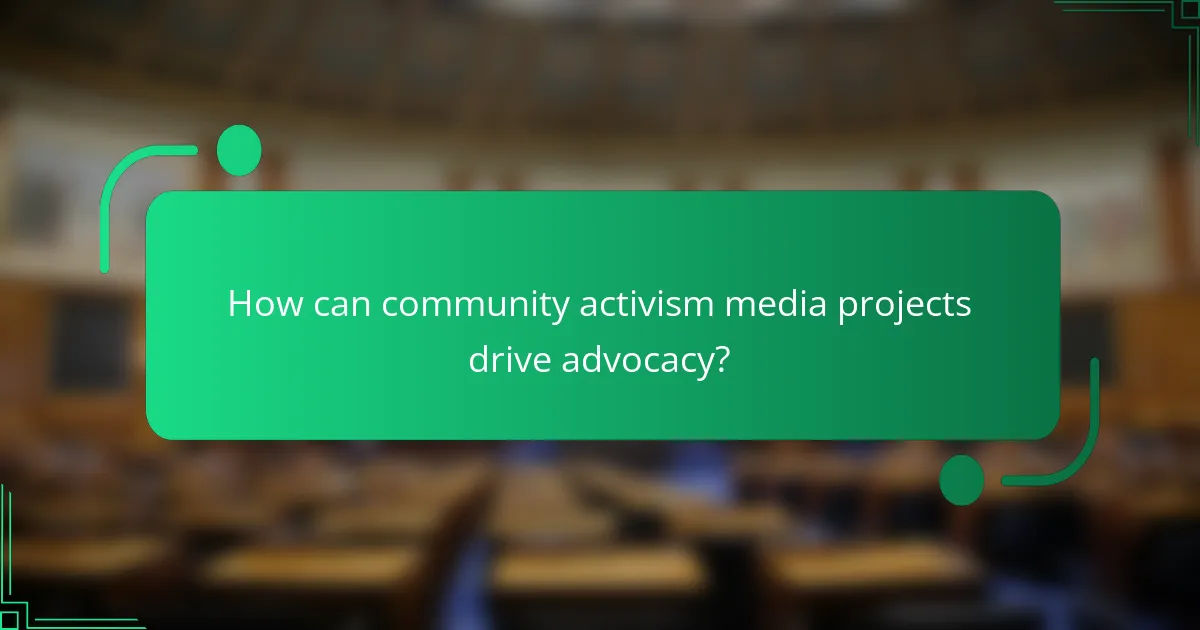
How can community activism media projects drive advocacy?
Community activism media projects can significantly enhance advocacy efforts by raising awareness, mobilizing individuals, and influencing policy changes. These projects utilize various media platforms to communicate messages, engage the public, and create a collective impact on social issues.
Increased awareness of social issues
Community activism media projects effectively raise awareness of pressing social issues by disseminating information through various channels such as social media, podcasts, and community events. By highlighting specific challenges, these projects can educate the public and foster a deeper understanding of the issues at hand.
For instance, a local campaign addressing homelessness might use video documentaries to showcase personal stories, thereby humanizing the issue and prompting community discussions. This approach can lead to increased empathy and support for initiatives aimed at addressing the problem.
Mobilization of community members
These media projects play a crucial role in mobilizing community members by encouraging participation in advocacy efforts. Through calls to action, events, and social media campaigns, they can galvanize individuals to get involved, whether through volunteering, attending meetings, or participating in protests.
For example, a project focused on environmental justice might organize clean-up events and invite community members to join. This not only raises awareness but also fosters a sense of community and shared responsibility, leading to greater collective action.
Influence on local policy changes
Community activism media projects can influence local policy changes by amplifying voices that advocate for specific reforms. By presenting compelling narratives and data, these projects can sway public opinion and pressure local officials to take action on critical issues.
A successful example could include a campaign that highlights the need for affordable housing, which gathers community testimonials and presents them to local government meetings. This direct engagement can lead to policy discussions and potential changes in zoning laws or funding allocations.
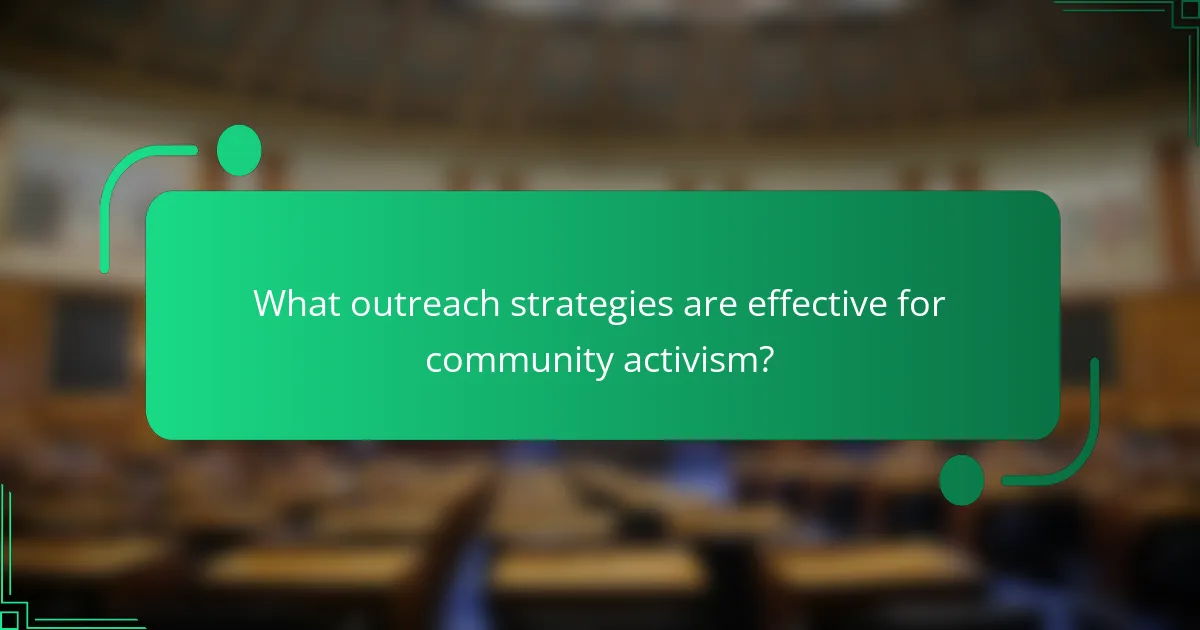
What outreach strategies are effective for community activism?
Effective outreach strategies for community activism include leveraging social media, organizing workshops and events, and forming partnerships with local organizations. These methods help raise awareness, engage community members, and foster collaboration towards common goals.
Social media campaigns
Social media campaigns are powerful tools for community activism, allowing organizations to reach a broad audience quickly and cost-effectively. Platforms like Facebook, Twitter, and Instagram can be used to share impactful stories, promote events, and mobilize supporters.
To maximize effectiveness, focus on creating engaging content that resonates with your target audience. Use visuals, such as images and videos, to capture attention and encourage sharing. Regularly analyze engagement metrics to refine your approach and ensure your message reaches the right people.
Community workshops and events
Hosting community workshops and events provides a platform for direct interaction and education. These gatherings can range from informational sessions to hands-on activities, allowing participants to learn about issues and solutions in a collaborative environment.
When planning events, consider the interests and needs of your community. Aim for inclusivity by offering events at various times and locations. Additionally, providing refreshments or incentives can increase attendance and participation.
Partnerships with local organizations
Forming partnerships with local organizations can amplify the impact of community activism efforts. Collaborating with established groups can provide access to resources, expertise, and networks that enhance outreach and effectiveness.
Identify organizations that share similar goals and values, and propose mutually beneficial initiatives. Regular communication and joint planning can strengthen these partnerships, ensuring that all parties are aligned and working towards common objectives.
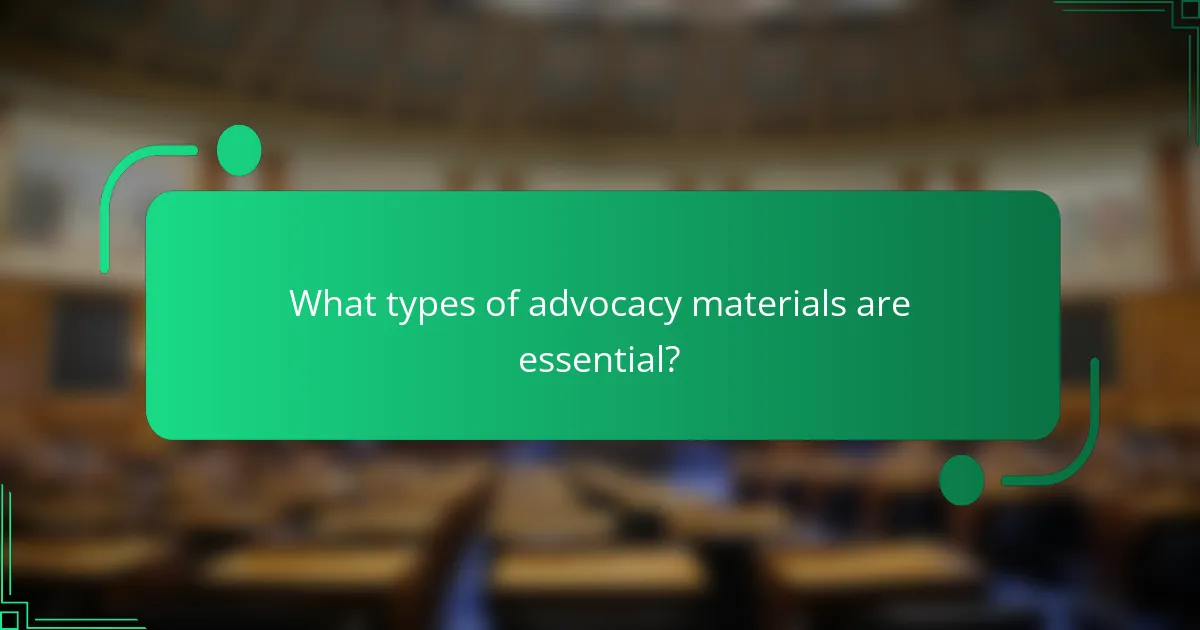
What types of advocacy materials are essential?
Essential advocacy materials include informational brochures, digital content for social media, and video documentaries that showcase community stories. These tools help convey messages, engage audiences, and promote community initiatives effectively.
Informational brochures
Informational brochures serve as a tangible resource for community members, providing key details about advocacy efforts, events, and resources. They should be visually appealing and concise, typically ranging from tri-fold designs to multi-page booklets.
When creating brochures, focus on clear messaging and include essential information such as contact details, event dates, and calls to action. Distributing these materials at community centers, local businesses, and events can enhance visibility and engagement.
Digital content for social media
Digital content for social media is crucial for reaching a broader audience and fostering community engagement. This can include posts, stories, infographics, and live videos that highlight advocacy efforts and encourage participation.
To maximize impact, tailor content to each platform’s audience. For instance, use eye-catching visuals on Instagram, informative threads on Twitter, and engaging videos on Facebook. Regular posting and interaction with followers can significantly boost community involvement.
Video documentaries showcasing community stories
Video documentaries that showcase community stories provide a powerful medium for advocacy, allowing personal narratives to resonate with viewers. These videos can highlight local issues, celebrate achievements, and inspire action within the community.
When producing documentaries, focus on storytelling techniques that evoke emotion and connection. Keep videos concise, ideally between 3 to 10 minutes, and ensure they are accessible through various platforms, such as YouTube or community websites. Engaging local filmmakers can enhance quality and authenticity.
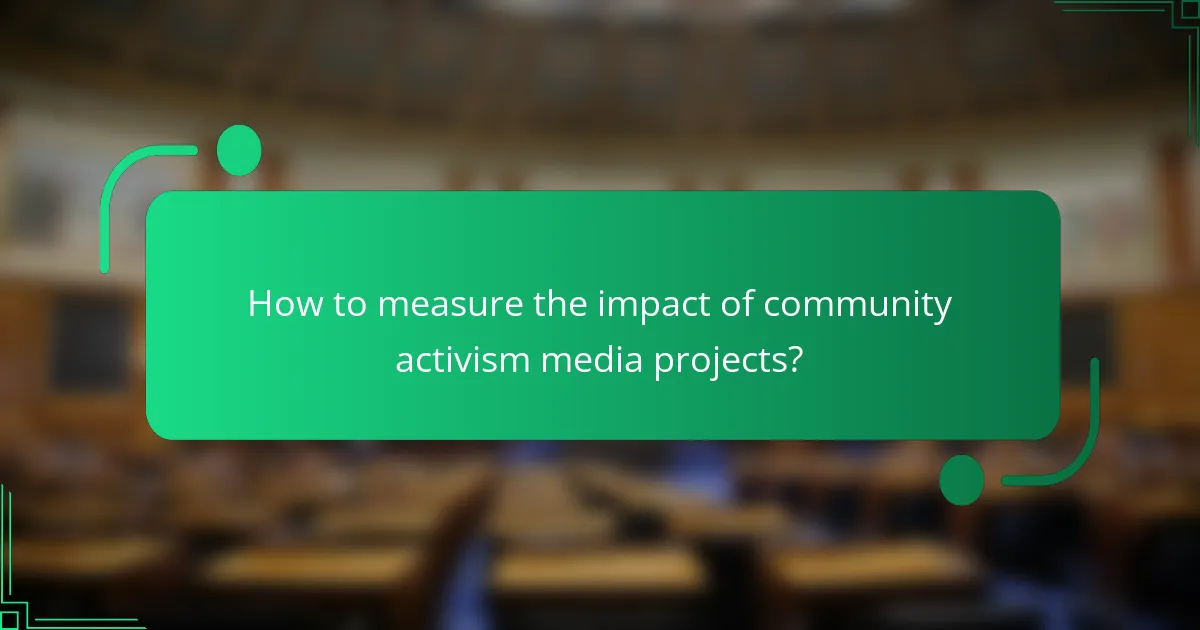
How to measure the impact of community activism media projects?
Measuring the impact of community activism media projects involves evaluating participant feedback, analyzing engagement metrics, and tracking any resulting policy changes. These methods provide insights into the effectiveness of outreach strategies and the overall influence of the projects on the community.
Surveys and feedback from participants
Gathering surveys and feedback from participants is a direct way to assess the impact of community activism media projects. This can include structured questionnaires or informal interviews that ask about participants’ experiences and perceived changes in their attitudes or behaviors.
Consider using a mix of quantitative and qualitative questions to capture a range of insights. For example, ask participants to rate their engagement on a scale from 1 to 10 and follow up with open-ended questions to gather detailed responses.
Analysis of engagement metrics
Engagement metrics provide quantitative data on how well community activism media projects are resonating with the audience. Key metrics to analyze include social media shares, likes, comments, and website traffic. These figures can indicate the level of interest and involvement from the community.
Utilize tools like Google Analytics or social media insights to track these metrics over time. Comparing engagement before and after project implementation can highlight shifts in community interest and participation.
Tracking policy changes influenced by projects
Tracking policy changes is crucial for understanding the broader impact of community activism media projects. This involves monitoring local or national legislation that may have been influenced by the advocacy efforts of the project. Look for direct correlations between project activities and policy outcomes.
Engage with local government or advocacy organizations to gather information on any policy shifts. Documenting these changes can provide compelling evidence of the project’s effectiveness and help secure future funding or support.
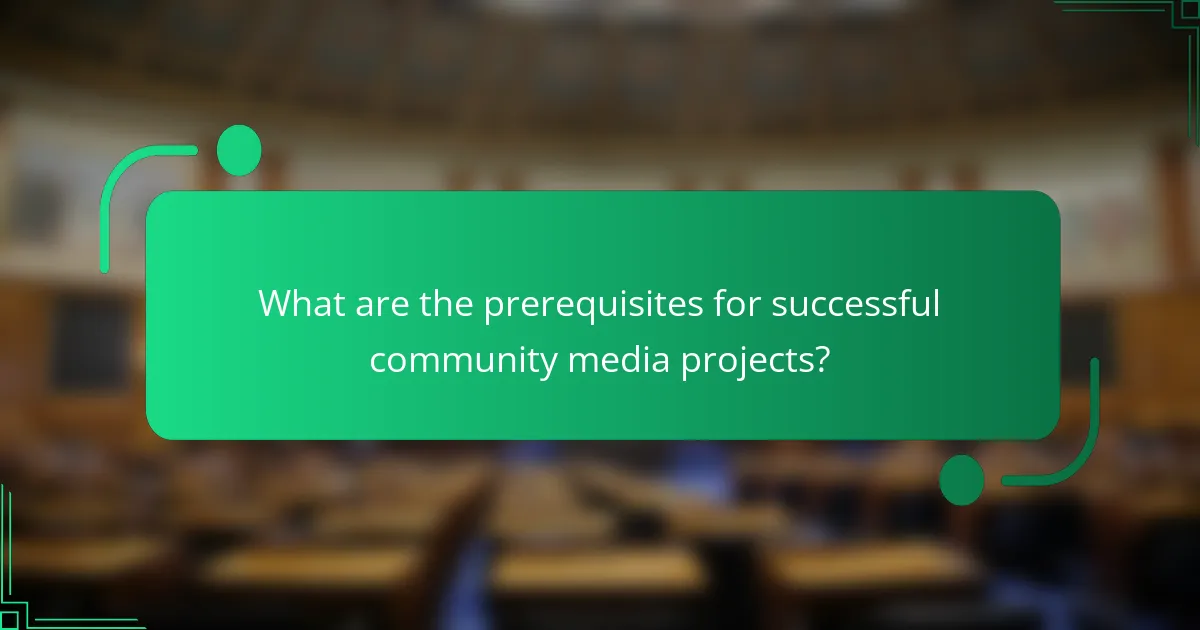
What are the prerequisites for successful community media projects?
Successful community media projects require a clear understanding of community needs, a diverse team of advocates, and effective outreach strategies. These elements ensure that the projects resonate with the target audience and drive meaningful impact.
Understanding community needs
To effectively address community needs, start by conducting thorough research through surveys, focus groups, and interviews. This helps identify the specific issues and interests of the community, allowing for tailored media content that engages and informs.
Consider utilizing local resources such as community centers or schools to gather insights. Engaging with community members directly fosters trust and encourages participation, which is crucial for the project’s success.
Building a diverse team of advocates
A diverse team brings a range of perspectives and experiences that enrich community media projects. Aim to include individuals from various backgrounds, including different ages, ethnicities, and socio-economic statuses, to ensure that the project reflects the community’s diversity.
Recruit volunteers or partners who are passionate about the cause and possess relevant skills, such as media production, graphic design, or social media management. This collaborative approach not only enhances creativity but also strengthens community ties and advocacy efforts.

How can technology enhance community activism efforts?
Technology can significantly boost community activism by facilitating communication, organizing efforts, and amplifying messages. Tools like social media, mobile apps, and data analytics help activists reach wider audiences and mobilize support more effectively.
Advocacy Materials
Creating effective advocacy materials is crucial for community activism. Digital platforms allow for the easy production and distribution of flyers, videos, and infographics that convey messages clearly and attractively. Utilizing tools like Canva or Adobe Spark can streamline this process, enabling activists to design professional-looking materials without extensive graphic design skills.
Consider tailoring materials to specific audiences by using localized language and relevant imagery. This approach can enhance engagement and ensure that the message resonates with the target demographic. For example, a campaign addressing environmental issues in a coastal community might feature local wildlife and emphasize regional impacts.
Outreach Strategies
Effective outreach strategies leverage technology to connect with community members and stakeholders. Social media platforms like Facebook, Twitter, and Instagram can be used to share updates, organize events, and foster discussions. Email newsletters and community forums also serve as valuable tools for maintaining ongoing communication.
When planning outreach, consider using targeted ads on social media to reach specific demographics. This can be particularly effective for local campaigns where geographic targeting is essential. Additionally, hosting virtual town halls or webinars can engage community members who may not attend in-person events.
Community Impact
Technology can amplify the impact of community activism by providing data-driven insights and facilitating collaboration. Tools for data collection and analysis, such as surveys or community mapping software, can help activists identify needs and measure progress. This evidence-based approach can strengthen advocacy efforts and attract funding or support.
Moreover, showcasing success stories through digital platforms can inspire others and build momentum. Sharing testimonials, case studies, or visual documentation of community projects can highlight the tangible benefits of activism. Engaging local media through press releases or social media can further extend the reach and impact of these stories.
